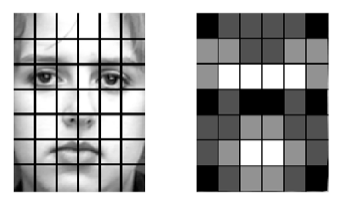This forum is disabled, please visit https://forum.opencv.org
 | 1 | initial version |
In opencv 3.0 the Alternative Chi-Square (method=CV_COMP_CHISQR_ALT) is introduced. This alternative formula is regularly used for texture comparison. For example, in [1] or in [2] this formula is used.
[1] Ahonen, T., Hadid, A., & Pietikäinen, M. (2004). Face recognition with local binary patterns. In Computer vision-eccv 2004 (pp. 469-481). Springer Berlin Heidelberg.
[2] Shan, C., Gong, S., & McOwan, P. W. (2009). Facial expression recognition based on local binary patterns: A comprehensive study. Image and Vision Computing, 27(6), 803-816.
The formula is as follows:

Moreover, in [1], several possible dissimilarity measures have been proposed for compare the histograms:
(THIS IS INCLUDED IN CASE OF FACE ANALYSIS AND LBP USING NEAREST-NEIGHBOR CLASSIFIER) Moreover, i think that this "idea" can be extended in order to compare other objects rather than faces, because it can be expected that some of the regions of an object contain more useful information than others.
When the image has been divided into regions, it can be expected that some of the regions contain more useful information than others in terms of distinguishing between people. For example, eyes seem to be an important cue in human face recognition. To take advantage of this, a weight can be set for each region based on the importance of the information it contains. For example,the weighted χ2 statistic becomes: [1]

in which wj is the weight for region j.
For example, in [2], the particular weight set we adopted was shown in the figura as follows, which was designed empirically based on the observation.

(Left) A face image divided into 6 7 sub-region. (Right) The weights set for weighted dissimilarity measure. Black squares indicate weight 0.0, dark gray 1.0, light gray 2.0 and white 4.0. [2]
 | 2 | No.2 Revision |
In opencv 3.0 the Alternative Chi-Square (method=CV_COMP_CHISQR_ALT) is introduced. This alternative formula is regularly used for texture comparison. For example, in [1] or in [2] this formula is used.
[1] Ahonen, T., Hadid, A., & Pietikäinen, M. (2004). Face recognition with local binary patterns. In Computer vision-eccv 2004 (pp. 469-481). Springer Berlin Heidelberg.
[2] Shan, C., Gong, S., & McOwan, P. W. (2009). Facial expression recognition based on local binary patterns: A comprehensive study. Image and Vision Computing, 27(6), 803-816.
The formula is as follows:

Moreover, in [1], several possible dissimilarity measures have been proposed for to compare the histograms:
(THIS IS INCLUDED IN CASE OF FACE ANALYSIS AND LBP USING NEAREST-NEIGHBOR CLASSIFIER) Moreover, i think that this "idea" can be extended in order to compare other objects rather than faces, because it can be expected that some of the regions of an object contain more useful information than others.
When the image has been divided into regions, it can be expected that some of the regions contain more useful information than others in terms of distinguishing between people. For example, eyes seem to be an important cue in human face recognition. To take advantage of this, a weight can be set for each region based on the importance of the information it contains. For example,the weighted χ2 statistic becomes: [1]

in which wj is the weight for region j.
For example, in [2], the particular weight set we adopted was shown in the figura as follows, which was designed empirically based on the observation.

(Left) A face image divided into 6 7 sub-region. (Right) The weights set for weighted dissimilarity measure. Black squares indicate weight 0.0, dark gray 1.0, light gray 2.0 and white 4.0. [2]
 | 3 | No.3 Revision |
In opencv 3.0 the Alternative Chi-Square (method=CV_COMP_CHISQR_ALT) is introduced. This alternative formula is regularly used for texture comparison. For example, in [1] or in [2] this formula is used.
[1] Ahonen, T., Hadid, A., & Pietikäinen, M. (2004). Face recognition with local binary patterns. In Computer vision-eccv 2004 (pp. 469-481). Springer Berlin Heidelberg.
[2] Shan, C., Gong, S., & McOwan, P. W. (2009). Facial expression recognition based on local binary patterns: A comprehensive study. Image and Vision Computing, 27(6), 803-816.
The formula is as follows:

Moreover, in [1], several possible dissimilarity measures have been proposed to compare the histograms:
(THIS IS INCLUDED IN CASE OF FACE ANALYSIS AND LBP USING NEAREST-NEIGHBOR CLASSIFIER) Moreover, i think that this "idea" can be extended in order to compare other objects rather than faces, because it can be expected that some of the regions of an object contain more useful information than others.
When the image has been divided into regions, it can be expected that some of the regions contain more useful information than others in terms of distinguishing between people. For example, eyes seem to be an important cue in human face recognition. To take advantage of this, a weight can be set for each region based on the importance of the information it contains. For example,the weighted χ2 statistic becomes: [1]

in which wj is the weight for region j.
For example, in [2], the particular weight set we adopted was shown in the figura figure as follows, which was designed empirically based on the observation.

(Left) A face image divided into 6 7 sub-region. (Right) The weights set for weighted dissimilarity measure. Black squares indicate weight 0.0, dark gray 1.0, light gray 2.0 and white 4.0. [2]